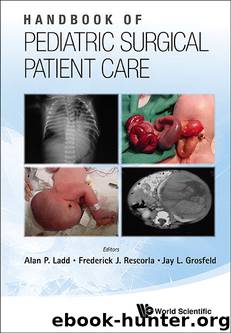Handbook of Pediatric Surgical Patient Care by JAY GROSFELD L ET AL

Author:JAY GROSFELD L ET AL [L ET AL, JAY GROSFELD]
Language: eng
Format: azw3
Publisher: World Scientific Publishing Company
Published: 2013-11-05T05:00:00+00:00
PATHOPHYSIOLOGY
No true data exists as to the relative incidence of congenital lung malformations in the general population or prevalence within annual rates of birth. The largest single-institution series reported individually or through cumulative reviews grossly depicts an annual series of 5–10 such patients presenting per year to tertiary-care, pediatric hospitals.5
Congenital Cystic Adenomatoid Malformation
CCAM is characterized by the hyperplastic, adenomatoid overgrowth of terminal respiratory bronchioles that form cysts of varying sizes. These intraparenchymal masses tend to be discrete entities within the developing lung with connections to the tracheobronchial tree, though rarely contain cartilage and are not true cysts.
Historically, CCAM has been classified by early descriptive terms put forth by Stocker in 1977.6 This classification delineated CCAM merely by the presence and nature of the associated cystic formations. Type I denoted lesions with large, often multiloculated cysts greater than 2 cm in diameter; where as type II lesions contained smaller cysts of less than 2 cm. Type III designations included those processes without cystic formation on gross inspection. Unfortunately, this classic categorization does not appropriately identify the overlapping described among hybrid types or the characterization of atypical forms. This “adenomatoid” formation may be more accurately described as a pulmonary hyperplastic process that is analogous to a pathologic growth from large airway obstruction, a possibility that may portend a physiologic etiology for these lesions.1
Large cyst type CCAM lesions often present early in infancy related to their relative expansion from air trapping. These enlarging lesions compress the adjacent lung leading to pulmonary function compromise and the possibility of cardiovascular collapse from mediastinal shift. Lesions that convey a significant mass effect may result in the development of pulmonary hypoplasia from its impact on normal parenchymal growth, and the possibility of resultant pulmonary vascular hypertension similar to that described for congenital diaphragmatic hernias. Thus patient morbidity will be impacted by the remaining degree of pulmonary hypoplasia evident, even following complete CCAM resection. Lesions are mostly confined to a single lobe and consist of cystic processes often greater than 2 cm in size, that may be multiple or multi-loculated. Up to 25% of these lesions may have an associated systemic arterial supply.1 Other large cystic processes of the lung that may be mistaken for CCAM include low-grade cystic pleuropulmonary blastoma, cystic intraparenchymal lymphangioma and pneumatocele. Small cyst type CCAM demonstrate a pattern of maldevelopment that closely resembles pathology from airway obstruction during development and this pattern of maldevelopment may represent a malformation sequence of pathology. These small cyst type lesions show regional replacement of the associated lung parenchyma with variable amounts of associated alveolar parenchyma. Reports of sarcomas arising from these adenomatoid malformations may represent low-grade cystic pleuropulmonary blastoma development. Bronchioloalveolar carcinoma and rhabdomyosarcoma have been seen in older patients in association to large cyst type of CCAM.3 This relationship to neoplastic change is often the touted rational for recommendations of surgical resection.
Download
This site does not store any files on its server. We only index and link to content provided by other sites. Please contact the content providers to delete copyright contents if any and email us, we'll remove relevant links or contents immediately.
The Art of Coaching by Elena Aguilar(52196)
Thinking, Fast and Slow by Kahneman Daniel(11798)
The Art of Thinking Clearly by Rolf Dobelli(9919)
The 5 Love Languages: The Secret to Love That Lasts by Gary Chapman(9287)
Mindhunter: Inside the FBI's Elite Serial Crime Unit by John E. Douglas & Mark Olshaker(8707)
When Breath Becomes Air by Paul Kalanithi(8042)
Periodization Training for Sports by Tudor Bompa(7928)
Becoming Supernatural by Dr. Joe Dispenza(7838)
Turbulence by E. J. Noyes(7704)
Bodyweight Strength Training by Jay Cardiello(7679)
Therapeutic Modalities for Musculoskeletal Injuries, 4E by Craig R. Denegar & Ethan Saliba & Susan Saliba(7601)
The Road Less Traveled by M. Scott Peck(7281)
Nudge - Improving Decisions about Health, Wealth, and Happiness by Thaler Sunstein(7247)
Mastermind: How to Think Like Sherlock Holmes by Maria Konnikova(6940)
Enlightenment Now: The Case for Reason, Science, Humanism, and Progress by Steven Pinker(6877)
Win Bigly by Scott Adams(6829)
Kaplan MCAT General Chemistry Review by Kaplan(6601)
Why We Sleep: Unlocking the Power of Sleep and Dreams by Matthew Walker(6362)
The Way of Zen by Alan W. Watts(6290)
